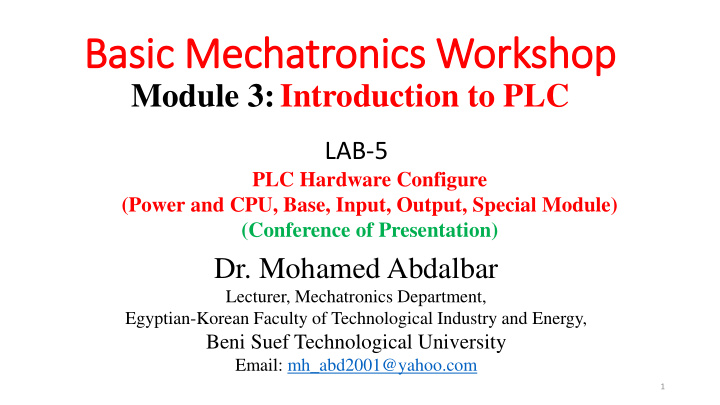



Basic Mechatronics Workshop Module 3: Introduction to PLC LAB-5 PLC Hardware Configure (Power and CPU, Base, Input, Output, Special Module) (Conference of Presentation) Dr. Mohamed Abdalbar Lecturer, Mechatronics Department, Egyptian-Korean Faculty of Technological Industry and Energy, Beni Suef Technological University Email: mh_abd2001@yahoo.com 1
LAB-5 PLC Hardware Configure (Power and CPU, Base, Input, Output, Special Module) (Conference of Presentation) Objectives Upon completion of this chapter, Student should be able to ✓ Define basic parts of a PLC ✓ Explain the function of power supply in the PLC. ✓ Explain the function of CPU (Controller/ Processor) in the PLC. ✓ Explain the Input/ Output (I/O) capabilities of PLC. ✓ Explain the discrete I/O architecture. ✓ Describe Analog I/O PLC module characteristics. ✓ Describe the functions of special module.
Basic parts of a PLC 1. Power Supply 2. Processor Module ✓ CPU ✓ Memory 3. Communication Interface. ✓ HMI – Status, ✓ HMI – Programming 4. I/O Modules ✓ Discrete/Digital Inputs ✓ Analog Inputs ✓ Output Modules
Basic parts of a PLC
Power Supply Usually, PLC power supplies require input from an AC power source; however, some PLCs will accept a DC power source. Those that will accept Most PLCs, however, require a 120 VAC or 220 VAC power sources, while a few controllers will accept 24 VDC. Since industrial facilities normally experience fluctuations in line voltage and frequency, a PLC power supply must be able to tolerate a 10 to 15% variation in line voltage conditions. The first step in estimating the load is to determine how many modules are required and then compute the total current requirement of these modules.
CPU (Controller/ Processor) • Processors are either modular or built into the PLC • They vary in processing speed and memory options. • Processor is optimized for high speed control and not general-purpose computing. Omron PLC CPU Unit CS1G-CPU44H Mitsubishi PLC CPU Module Siemens PLC CPU 315-2DP
CPU (Controller/ Processor) CPU Functions: RUN 1. Executes the operating • Places the proce ssor in the Run mode system • Runs Ladder program and en ergizes output devices 2. Manages memory, • Prevents online program editing in this position 3. Monitors inputs, • Prevents use of programmer/o perator interface 4. Evaluates the means for connecting to an external device to change the processor mode programming device 5. Provide system PROG Position • Sets the processor in the Progra m mode diagnostics with status • Prevents the processor from scanning or executing LED indicators. 6. It may have a switch for the ladder program, and the controller outputs are de- selecting mode of energized • Enables program entry and ed iting operation: ✓ RUN, • Prevents you from using a programmer/operator ✓ PROG interface device to change the processor mode ✓ REM REM Position • Places the processor in the Remote mode: either the REMote Run, REMote Program, or REMote Test mode • Allows you to change the processor mod e from a programmer/operator interface device • Allows you to perform online program editing
Input/ Output (I/O) capabilities
Input/ Output (I/O) capabilities
Discrete I/O Energizing an input channel lights the LED inside the optocoupler, turning on the phototransistor, sending a "high" signal to the PLC’s microprocessor, setting (1) that bit in the PLC’s input register.
Discrete I/O Setting a bit (1) in the PLC’s output register sends a "high" signal to the LED inside the optocoupler, turning on the photo-TRIAC, sending AC power to the output channel to energize the load.
Discrete I/O If the discrete device connecting to the PLC is not polarity-sensitive, either type of PLC I/O module will suffice . For example, the following diagrams show a mechanical limit switch connecting to a sinking PLC input and to a sourcing PLC input:
Analog I/O All PLCs are digital devices at heart. Thus, in order to interface with an analog sensor or control device, some “translation” is necessary between the analog and digital worlds. Inside every analog input module is an ADC, or Analog-to-Digital Converter, circuit designed to convert an analog electrical signal into a multi-bit binary word. Conversely, every analog output module contains a DAC, or Digital-to-Analog Converter, circuit to convert the PLC’s digital command words into analog electrical quantities. Analog I/O is commonly available for modular PLCs for many different analog signal types, including: ✓ Voltage (0 to 10 volt, 0 to 5 volt) ✓ Current (0 to 20 mA, 4 to 20 mA) ✓ Thermocouple (millivoltage) ✓ RTD (millivoltage) 4-O - FBs-4DA - FATEK ✓ Strain gauge (millivoltage) Automation Corp.
Network I/O • Many different digital network standards exist for PLCs to communicate with, from PLC to PLC and between PLCs and field devices. One of the earliest digital protocols developed for PLC communication was Modbus, originally for the Modicon brand of PLC. Modbus was adopted by other PLC and industrial device manufacturers as a de facto standard and remains perhaps the most universal digital protocol available for industrial digital devices today. • Another digital network standard developed by a particular manufacturer and later adopted as a de facto standard is Profibus, originally developed by Siemens .
Special module
Recommend
More recommend